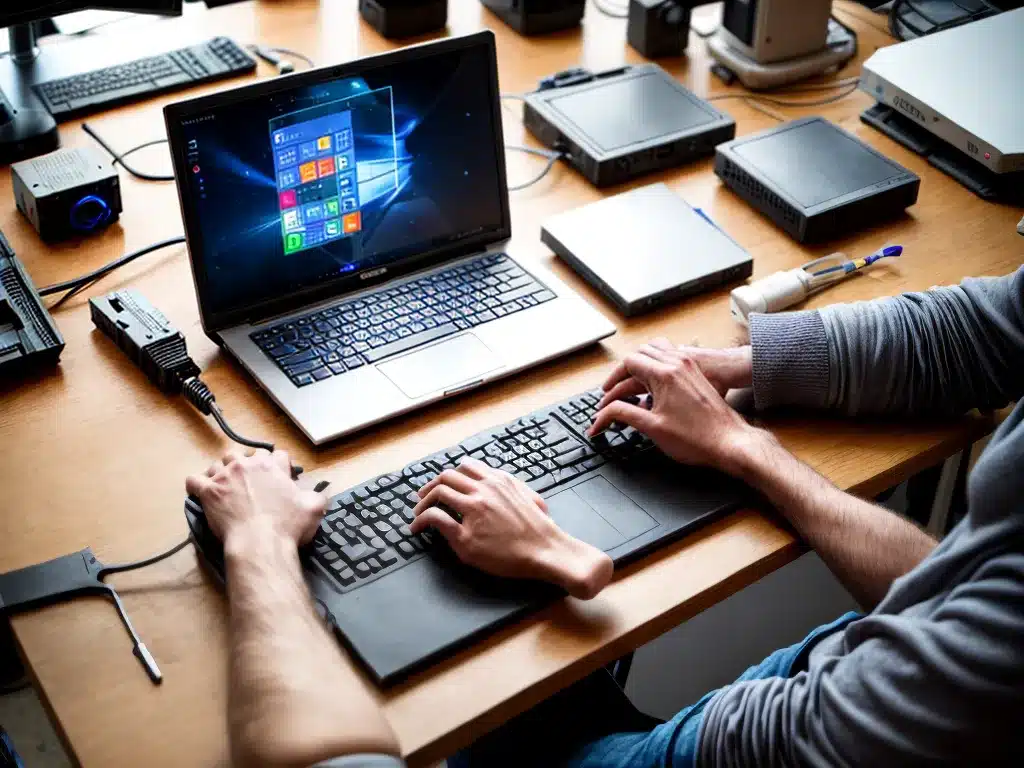Introduction
As someone who regularly repairs computers, having the right tools on hand is essential for efficiently diagnosing issues and completing repairs. Over the years, I’ve found there are 5 must-have tools that I use for most basic computer repairs. Having these tools readily available saves me time and frustration when tackling common problems like hardware malfunctions, software crashes, and performance issues. In this article, I’ll share my top 5 go-to tools for basic computer repairs along with examples of how I use each one.
1. Phillips and Flathead Screwdrivers
The most basic tools that every computer repair toolkit needs are a Phillips and flathead screwdriver. Many computer cases and components are held in place with Phillips head screws. You’ll need a Phillips screwdriver to open up the computer case to access internal components like the motherboard, RAM, hard drives, etc. I always keep a #1 and #2 Phillips screwdriver on hand to handle different screw sizes.
Flathead screwdrivers are also essential for separating components that use clamps or for prying off glued on pieces like RAM heat spreader plates. I recommend getting a small and medium sized flathead screwdriver.
Having both Phillips and flathead screwdrivers in multiple sizes allows me to disassemble computers and access any internal components I need to troubleshoot or replace.
2. Anti-Static Wrist Band
One of the most important tools for working inside a computer is an anti-static wrist band. This is a must-have anytime you need to handle sensitive electronic components like the motherboard, CPU, RAM sticks, expansion cards, etc. An anti-static band grounds your body to prevent damaging static discharges as you work on computer hardware.
I connect the clip to a metal part of the computer case and wear the band on my wrist whenever I open up the case. The wrist band neutralizes any built-up static electricity and protects the components. Using an anti-static band prevents me from accidentally shocking and damaging expensive parts through normal movement. This inexpensive tool saves me from having to replace components damaged by ESD (electro-static discharge).
3. Computer Tool Kit
A computer tool kit contains useful tools for disassembling computers, tightening screws, manipulating cables, etc. I always have a small computer tool kit on hand that contains:
- Tweezers – for retrieving small screws or maneuvering cables
- Zip ties – for wrangling cable clutter
- Precision screwdrivers – for components with tiny screws
- Wire cutters – for trimming cable ties or cutting wires
- Hex keys – for tightening hex screws on SSD/HDD mounts
- Pliers – for bending or cutting metal pieces
- Scraper – for removing old thermal paste from CPUs
Having this assortment of tools allows me to efficiently take computers apart, organize cabling, secure components, remove stuck parts, and tidy things up. The variety of precision tools in a computer tool kit makes it possible for me to work on the small form factors found inside laptops and desktops.
4. External Hard Drive Enclosure
When troubleshooting computer issues, I often need to access data on the hard drive or test components like the power supply. An external hard drive enclosure allows me to mount an internal hard drive and connect it via USB to another computer.
I use external enclosures to:
- Retrieve personal files from a computer that won’t boot
- Check hard drives for errors by running diagnostics from another PC
- Erase drives securely before recycling old computers
- Clone hard drives when upgrading or migrating data
Having an external enclosure on hand prevents me from having to physically install a drive in another desktop when I need to access the data. I recommend getting both 2.5″ and 3.5″ enclosures to handle laptop and desktop hard drives.
5. Flash Drives
Flash drives are incredibly handy for computer repairs. I keep several flash drives loaded with tools like:
- Bootable operating system ISO files – for accessing computers with corrupt OS installations
- Recovery software – for retrieving lost or deleted data
- Diagnostic tools – for testing hardware components
- Antivirus software – for detecting and removing malware
- System utilities – for checking disk errors, cloning drives, stress testing, etc.
With these flash drive “toolkits”, I can boot into alternative operating systems to access data and troubleshoot problems. Or I can run diagnostics and recovery software without having to install anything on the computer.
Flash drives give me portable access to all the software tools I need for repairs. I always keep multiple prepared flash drives in my toolkit for tackling various issues I encounter.
Conclusion
Having the right basic tools on hand makes a world of difference when repairing computers. Investing in high-quality Phillips and flathead screwdrivers, an anti-static wristband, a computer tool kit, hard drive enclosures, and prepared flash drives will equip you to efficiently handle many common repairs. With these 5 must-have tools in your toolkit, you’ll gain the ability to troubleshoot and resolve a wide range of computer problems. Having the proper tools saves significant time and prevents damage when working on computer hardware and performing repairs.













